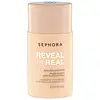What's inside
What's inside
 Key Ingredients
Key Ingredients

 Benefits
Benefits

 Concerns
Concerns

No concerns
 Ingredients Side-by-side
Ingredients Side-by-side

Water
Skin ConditioningCyclopentasiloxane
EmollientButylene Glycol
HumectantGlycerin
HumectantDisteardimonium Hectorite
StabilisingCetyl PEG/PPG-10/1 Dimethicone
EmulsifyingLauryl PEG-10 Tris(Trimethylsiloxy)Silylethyl Dimethicone
EmulsifyingPhenoxyethanol
PreservativeMagnesium Sulfate
Triethoxycaprylylsilane
Ethylhexylglycerin
Skin ConditioningDimethicone/Vinyl Dimethicone Crosspolymer
Skin ConditioningSqualane
EmollientSodium Hyaluronate
HumectantHydrolyzed Hyaluronic Acid
HumectantCI 77891
Cosmetic ColorantIron Oxides
CI 77492
Cosmetic ColorantCI 77499
Cosmetic ColorantWater, Cyclopentasiloxane, Butylene Glycol, Glycerin, Disteardimonium Hectorite, Cetyl PEG/PPG-10/1 Dimethicone, Lauryl PEG-10 Tris(Trimethylsiloxy)Silylethyl Dimethicone, Phenoxyethanol, Magnesium Sulfate, Triethoxycaprylylsilane, Ethylhexylglycerin, Dimethicone/Vinyl Dimethicone Crosspolymer, Squalane, Sodium Hyaluronate, Hydrolyzed Hyaluronic Acid, CI 77891, Iron Oxides, CI 77492, CI 77499
Water
Skin ConditioningIsododecane
EmollientDimethicone
EmollientCI 77891
Cosmetic ColorantAlcohol Denat.
AntimicrobialBoron Nitride
AbsorbentButylene Glycol
HumectantPEG-10 Dimethicone
Skin ConditioningPhenyl Trimethicone
Skin ConditioningDisteardimonium Hectorite
StabilisingMagnesium Sulfate
Hydroxyacetophenone
AntioxidantCI 77492
Cosmetic ColorantPEG/PPG-18/18 Dimethicone
EmulsifyingDimethiconol
EmollientChlorphenesin
AntimicrobialCI 77491
Cosmetic ColorantTropaeolum Majus Flower/Leaf/Stem Extract
Skin ConditioningTriethoxycaprylylsilane
Tetrasodium Glutamate Diacetate
1,2-Hexanediol
Skin ConditioningCaprylyl Glycol
EmollientCI 77499
Cosmetic ColorantWater, Isododecane, Dimethicone, CI 77891, Alcohol Denat., Boron Nitride, Butylene Glycol, PEG-10 Dimethicone, Phenyl Trimethicone, Disteardimonium Hectorite, Magnesium Sulfate, Hydroxyacetophenone, CI 77492, PEG/PPG-18/18 Dimethicone, Dimethiconol, Chlorphenesin, CI 77491, Tropaeolum Majus Flower/Leaf/Stem Extract, Triethoxycaprylylsilane, Tetrasodium Glutamate Diacetate, 1,2-Hexanediol, Caprylyl Glycol, CI 77499
 Reviews
Reviews

Ingredients Explained
These ingredients are found in both products.
Ingredients higher up in an ingredient list are typically present in a larger amount.
Butylene Glycol (or BG) is used within cosmetic products for a few different reasons:
Overall, Butylene Glycol is a safe and well-rounded ingredient that works well with other ingredients.
Though this ingredient works well with most skin types, some people with sensitive skin may experience a reaction such as allergic rashes, closed comedones, or itchiness.
Learn more about Butylene GlycolCi 77492 is also hydrated iron III oxide. It's sole purpose is to give a yellow hue to products.
Iron III oxides are classified as inorganic chemicals for coloring.
Synthetically created Ci 77492 is considered safer than those naturally found. This is because the synthetically created version may contain less impurities. Iron oxides are generally non-toxic and non-allergenic.
Learn more about CI 77492Ci 77499 is also hydrated iron III oxide. It is created from mixing red and black iron oxides. This helps give shades of darkness to a product.
Iron III oxides are classified as inorganic chemicals for coloring.
Ci 77891 is a white pigment from Titanium dioxide. It is naturally found in minerals such as rutile and ilmenite.
It's main function is to add a white color to cosmetics. It can also be mixed with other colors to create different shades.
Ci 77891 is commonly found in sunscreens due to its ability to block UV rays.
Learn more about CI 77891Disteardimonium Hectorite comes from the clay mineral named hectorite. It is used to add thickness to a product.
It can also help stabilize a product by helping to disperse other ingredients.
Hectorite is a rare, white clay mineral.
Learn more about Disteardimonium HectoriteMagnesium Sulfate is a salt. More specifically, it is an epsom salt, or the bath salt used to help relieve muscle aches.
Despite having ‘sulfate’ in the name, it isn’t a surfactant or cleansing agent like sodium lauryl sulfate. Unlike those sulfates, magnesium sulfate doesn’t have the same cleansing or foaming properties (it's simply a type of salt).
In cosmetics, Magnesium Sulfate is used to thicken a product or help dilute other solids. It is a non-reactive and non-irritating ingredient.
One study shows magnesium deficiency may lead to inflammation of the skin. Applying magnesium topically may help reduce inflammation.
You can find this ingredient in sea water or mineral deposits.
Learn more about Magnesium SulfateTriethoxycaprylylsilane is a silicone used to bind and stabilize ingredients.
As an emulsifier, it helps prevent ingredients from separating. This can help elongate the shelf life of products.
Triethoxycaprylylsilane is often used to coat mineral sunscreens ingredients to help give a better feel. It also helps reduce oxidative stress in sunscreens.
Learn more about TriethoxycaprylylsilaneWater. It's the most common cosmetic ingredient of all. You'll usually see it at the top of ingredient lists, meaning that it makes up the largest part of the product.
So why is it so popular? Water most often acts as a solvent - this means that it helps dissolve other ingredients into the formulation.
You'll also recognize water as that liquid we all need to stay alive. If you see this, drink a glass of water. Stay hydrated!
Learn more about Water